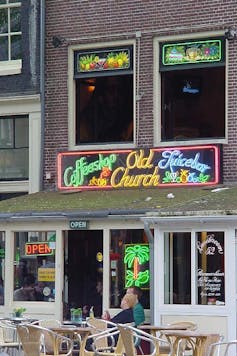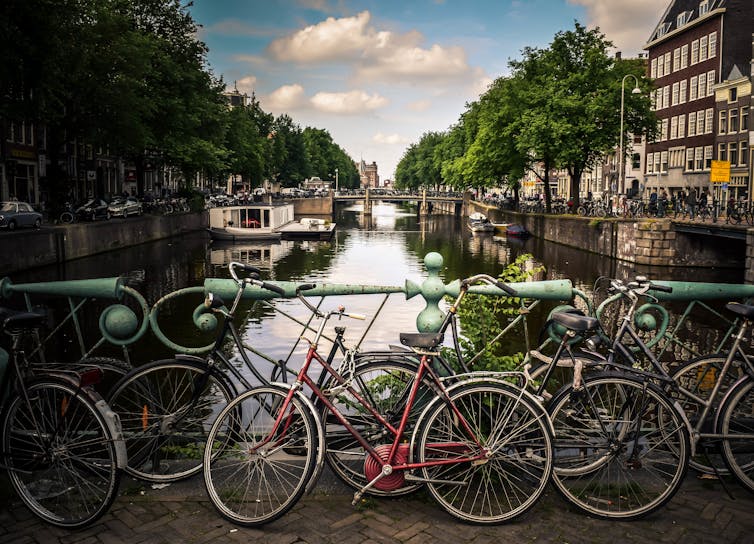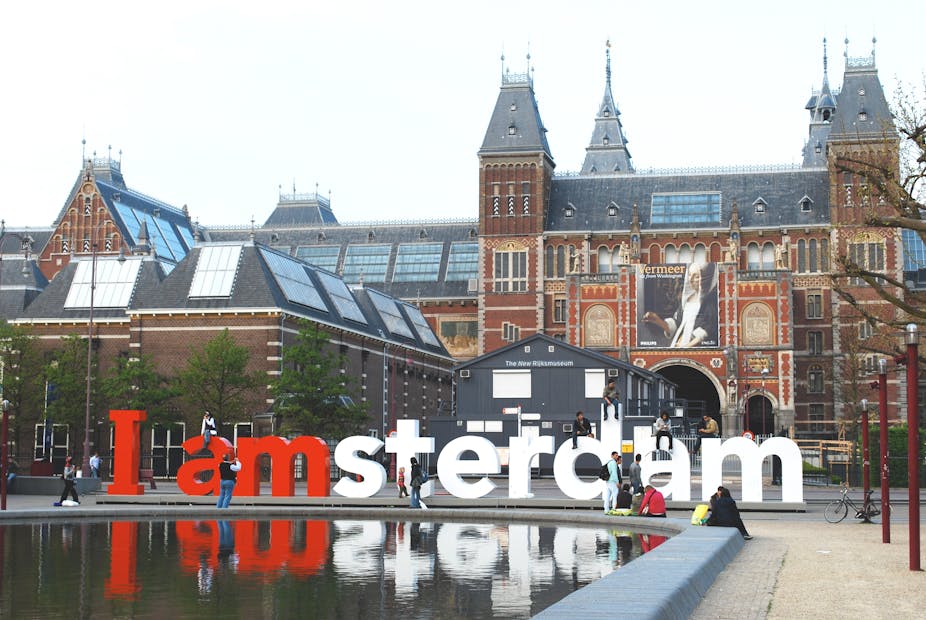Facing international competition to attract people, jobs, firms and more, cities are establishing branding strategies. But to succeed they must identify key factors and values, and especially address the central question of identity.
The city in all its complexity
“Urban marketing”, “city marketing” and “city branding” all fall under the same category, the methods for promoting territories. Their common goal is to seek to develop among residents and visitors alike shared impressions that reveal the attractiveness of a particular place. Like nation branding, city branding contributes to structuring a city’s diversity into a narrative that can persuade, in the context of competition between cities, citizens, residents and visitors.
My approach focused on communication, and Amsterdam’s “I Amsterdam” campaign – started in 2004, it’s one of the first examples of city branding in Europe and now one of the longest-lived – raised a number of interesting questions. The initial series related to the city’s identity: Can the urban brand operate as an umbrella, covering a multitude of stakeholders and audiences? Can it create a positive feeling in the mind of all those who meet the city that they want to develop a relation with it? How do citizens, tourists and firms develop a “feeling of affiliation”?
The second question relating to the appropriate scale of the territory: What situation fits Amsterdam the most? As a global community linked to a global culture, or communities that stand apart from the geographical and historical context of the Netherlands?

Rebranding Amsterdam to update its identity
The rebranding package, launched in 2004, contains a shared brand, “I Amsterdam,” with a logo developed for city promotion, institutional bodies and partners. The purpose was to create a shared identity of the city’s 741,000 inhabitants and an attractive perception for the millions of tourists who visit every year.
The work began in 2002 and the starting point was to evaluate how Amsterdam ranked on several criteria. The city benefits from its centuries-old history as a trade center, its wealth of culture and innovation. It’s now 8th on the Global Power City Index 2016, which for a city of its size is high. Yet Amsterdam’s position is threatened by European and international competition. Even within the Netherlands, The Hague is the de facto the political centre, while Rotterdam is a challenger in the commercial sphere.
Moreover, Amsterdam’s attractiveness as a tourism destination was founded on two major historical themes, the second of which overshadows more-desirable aspects of the city’s aspirations.

The first historical theme dates back to “The Golden Age” of the Netherlands in the 17th Century. As the Dutch East India Company established colonies all over Asia, Africa and the Americas, Amsterdam exerted its influence as an economic, cultural and scientific power. The paintings of Johannes Vermeer testify the wealth of the trading city and its attractiveness for prosperous European migrants.
At the end of the 1960s, a second image of Amsterdam became dominant, born out of the city’s tradition of openness and tolerance. To attract more visitors than just those who come to smoke in the coffee shops and gaze through windows in the red-light district, city alderman Geert Dales and others decided that it was essential for Amsterdam to reimagine itself.
“I Amsterdam” was not the first attempt to brand the city. Previous slogans – “Amsterdam has it,” “Amsterdam, capital of inspiration,” “Small city, big business,” and “Cool capital” – were ultimately unable to express distinctive benefits and key values of Amsterdam.
A city-branding campaign’s key elements

Positioning : The three core values of “spirit of commerce”, “creativity” and “innovation” have been the city’s strengths for centuries. The 16 dimensions represented in graph to the left were considered to be priorities. Among them, 6 have been considered as priorities by the marketing organisation: “City of culture”, “City of canals”, and “City of meetings” are already strong dimensions, where the city continues to benefit from them. “City of knowledge”, “Business city” and “Residential city” need strengthening and investments to benefit from them. The graph shows that Amsterdam wants to de-emphasize its image as a city of “sex, drugs, and R&R” (though this has contributed to some of its current popularity).
Targets: “Whom do we want to attract to our city?” is a foundational question of a city-branding strategy. In “Amsterdam TM, the City as a Business”, the goal was to give Amsterdam a distinctive position that goes hand-in-hand with an image that attracts businesses and residents.
Slogan and logo
An agency was hired to develop a slogan and logo that would underpin the whole campaign: “I Amsterdam” was chosen to carry the brand. This slogan has the advantage of being able to express the entire range of the key values and dimensions while allowing target audiences to build in their own way to relate with the Amsterdam brand. Visually, “I am” is highlighted in red. In this way, the city is giving a front seat to citizens, tourists and companies to be involved in the city-marketing project. The “I Amsterdam” logo became an urban sculpture in one of the most photographed spots in Amsterdam, on the Museumplein in front of the Rijksmuseum.

The goal was to have a slogan that was clear, short, powerful and easy to remember, as well as one that had a good potential for people to identify with it. Who more than the citizens of Amsterdam could feel that they “are” Amsterdam?
A city brand, for what purpose and for whom?
The primary goal of the city branding was to attract visitors and investors, with an expectation that it would also reinforce citizens’ identity as a ripple effect. This was intended as a way to integrate locals in the process, but was not as successful as hoped. At that time, the Amsterdam case shows that citizens were not the main targets, even if the marketing messages mentioned them. This could be one of the limits of city-marketing strategies.
Even if there may be some concrete benefits while promoting the brand, a city is more than the coexistence of different populations and urban areas – it’s a combination of services and people under a policy linked with the history.
The secondary result is related to the appropriate scale of the territory and the most suitable situation of Amsterdam, both within its region and the country as a whole. For centuries, citizens live in particular places and travel into or across physical borders. But, information-technology and networks were supposed to erase borders.
The process of clarifying values and positioning the city is one of elaboration and reconstruction of an identity influenced by digital and physical registers. The question of the adoption of shared values by inhabitants, tourists and businessmen cannot be solved with communication solutions alone.
The core values developed by Amsterdam rely on (real) values from the 17th Century. Therefore, as the city marketing for Amsterdam (and other cities as well) founded itself partly on historical values, the risk could be to freeze the perception of the city. If we look at the reasons that a branding effort did or didn’t succeed, a shared project develop by the actors could represent a solution: To transform a city is to go beyond its social and political existing story in order to elaborate a new one.

Note: The author had no connection to the “I Amsterdam” branding campaign nor any other activities related to the promotion of Amsterdam.

